Fangfang Zhang
Bridging Fitness With Search Spaces By Fitness Supremums: A Theoretical Study on LGP
May 28, 2025Abstract:Genetic programming has undergone rapid development in recent years. However, theoretical studies of genetic programming are far behind. One of the major obstacles to theoretical studies is the challenge of developing a model to describe the relationship between fitness values and program genotypes. In this paper, we take linear genetic programming (LGP) as an example to study the fitness-to-genotype relationship. We find that the fitness expectation increases with fitness supremum over instruction editing distance, considering 1) the fitness supremum linearly increases with the instruction editing distance in LGP, 2) the fitness infimum is fixed, and 3) the fitness probabilities over different instruction editing distances are similar. We then extend these findings to explain the bloat effect and the minimum hitting time of LGP based on instruction editing distance. The bloat effect happens because it is more likely to produce better offspring by adding instructions than by removing them, given an instruction editing distance from the optimal program. The analysis of the minimum hitting time suggests that for a basic LGP genetic operator (i.e., freemut), maintaining a necessarily small program size and mutating multiple instructions each time can improve LGP performance. The reported empirical results verify our hypothesis.
Multi-task Geometric Estimation of Depth and Surface Normal from Monocular 360° Images
Nov 04, 2024



Abstract:Geometric estimation is required for scene understanding and analysis in panoramic 360{\deg} images. Current methods usually predict a single feature, such as depth or surface normal. These methods can lack robustness, especially when dealing with intricate textures or complex object surfaces. We introduce a novel multi-task learning (MTL) network that simultaneously estimates depth and surface normals from 360{\deg} images. Our first innovation is our MTL architecture, which enhances predictions for both tasks by integrating geometric information from depth and surface normal estimation, enabling a deeper understanding of 3D scene structure. Another innovation is our fusion module, which bridges the two tasks, allowing the network to learn shared representations that improve accuracy and robustness. Experimental results demonstrate that our MTL architecture significantly outperforms state-of-the-art methods in both depth and surface normal estimation, showing superior performance in complex and diverse scenes. Our model's effectiveness and generalizability, particularly in handling intricate surface textures, establish it as a new benchmark in 360{\deg} image geometric estimation. The code and model are available at \url{https://github.com/huangkun101230/360MTLGeometricEstimation}.
Multi-Representation Genetic Programming: A Case Study on Tree-based and Linear Representations
May 23, 2024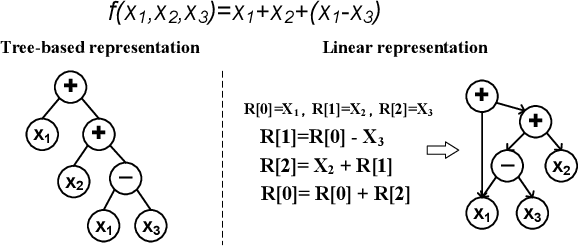
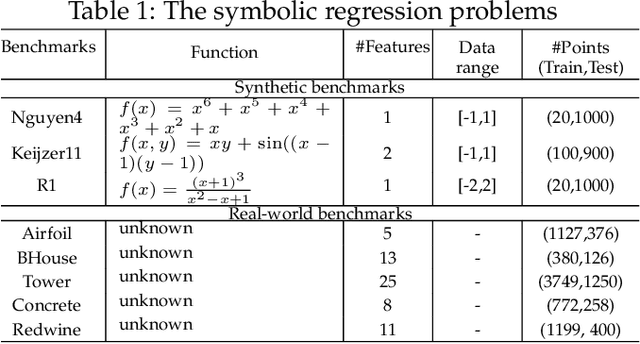
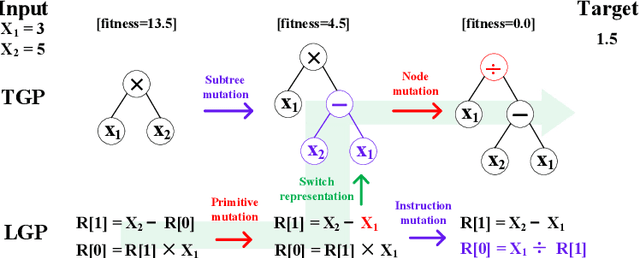
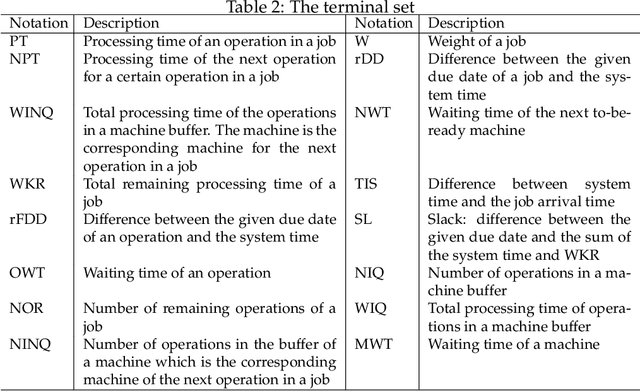
Abstract:Existing genetic programming (GP) methods are typically designed based on a certain representation, such as tree-based or linear representations. These representations show various pros and cons in different domains. However, due to the complicated relationships among representation and fitness landscapes of GP, it is hard to intuitively determine which GP representation is the most suitable for solving a certain problem. Evolving programs (or models) with multiple representations simultaneously can alternatively search on different fitness landscapes since representations are highly related to the search space that essentially defines the fitness landscape. Fully using the latent synergies among different GP individual representations might be helpful for GP to search for better solutions. However, existing GP literature rarely investigates the simultaneous effective use of evolving multiple representations. To fill this gap, this paper proposes a multi-representation GP algorithm based on tree-based and linear representations, which are two commonly used GP representations. In addition, we develop a new cross-representation crossover operator to harness the interplay between tree-based and linear representations. Empirical results show that navigating the learned knowledge between basic tree-based and linear representations successfully improves the effectiveness of GP with solely tree-based or linear representation in solving symbolic regression and dynamic job shop scheduling problems.
Image encryption for Offshore wind power based on 2D-LCLM and Zhou Yi Eight Trigrams
Jun 02, 2023
Abstract:Offshore wind power is an important part of the new power system, due to the complex and changing situation at ocean, its normal operation and maintenance cannot be done without information such as images, therefore, it is especially important to transmit the correct image in the process of information transmission. In this paper, we propose a new encryption algorithm for offshore wind power based on two-dimensional lagged complex logistic mapping (2D-LCLM) and Zhou Yi Eight Trigrams. Firstly, the initial value of the 2D-LCLM is constructed by the Sha-256 to associate the 2D-LCLM with the plaintext. Secondly, a new encryption rule is proposed from the Zhou Yi Eight Trigrams to obfuscate the pixel values and generate the round key. Then, 2D-LCLM is combined with the Zigzag to form an S-box. Finally, the simulation experiment of the algorithm is accomplished. The experimental results demonstrate that the algorithm can resistant common attacks and has prefect encryption performance.
Quantitative Method for Security Situation of the Power Information Network Based on the Evolutionary Neural Network
Nov 26, 2022Abstract:Cybersecurity is the security cornerstone of digital transformation of the power grid and construction of new power systems. The traditional network security situation quantification method only analyzes from the perspective of network performance, ignoring the impact of various power application services on the security situation, so the quantification results cannot fully reflect the power information network risk state. This study proposes a method for quantifying security situation of the power information network based on the evolutionary neural network. First, the security posture system architecture is designed by analyzing the business characteristics of power information network applications. Second, combining the importance of power application business, the spatial element index system of coupled interconnection is established from three dimensions of network reliability, threat, and vulnerability. Then, the BP neural network optimized by the genetic evolutionary algorithm is incorporated into the element index calculation process, and the quantitative model of security posture of the power information network based on the evolutionary neural network is constructed. Finally, a simulation experiment environment is built according to a power sector network topology, and the effectiveness and robustness of the method proposed in the study are verified.
Review on Monitoring, Operation and Maintenance of Smart Offshore Wind Farms
Nov 01, 2022Abstract:In recent years, with the development of wind energy, the number and scale of wind farms are developing rapidly. Since offshore wind farm has the advantages of stable wind speed, clean, renewable, non-polluting and no occupation of cultivated land, which has gradually become a new trend of wind power industry all over the world. The operation and maintenance mode of offshore wind power is developing in the direction of digitization and intelligence. It is of great significance to carry out the research on the monitoring, operation and maintenance of offshore wind farm, which will be of benefits to reduce the operation and maintenance cost, improve the power generation efficiency, improve the stability of offshore wind farm system and build smart offshore wind farm. This paper will mainly analyze and summarize the monitoring, operation and maintenance of offshore wind farm, especially from the following points: monitoring of "offshore wind power engineering & biological & environment", the monitoring of power equipment and the operation & maintenance of smart offshore wind farms. Finally, the future research challenges about monitoring, operation and maintenance of smart offshore wind farm are proposed, and the future research directions in this field are prospected.
* accepted by Sensors
WRHT: Efficient All-reduce for Distributed DNN Training in Optical Interconnect System
Jul 22, 2022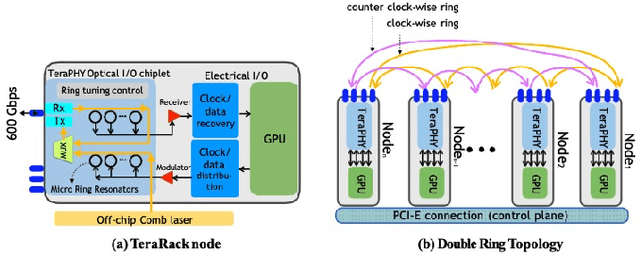
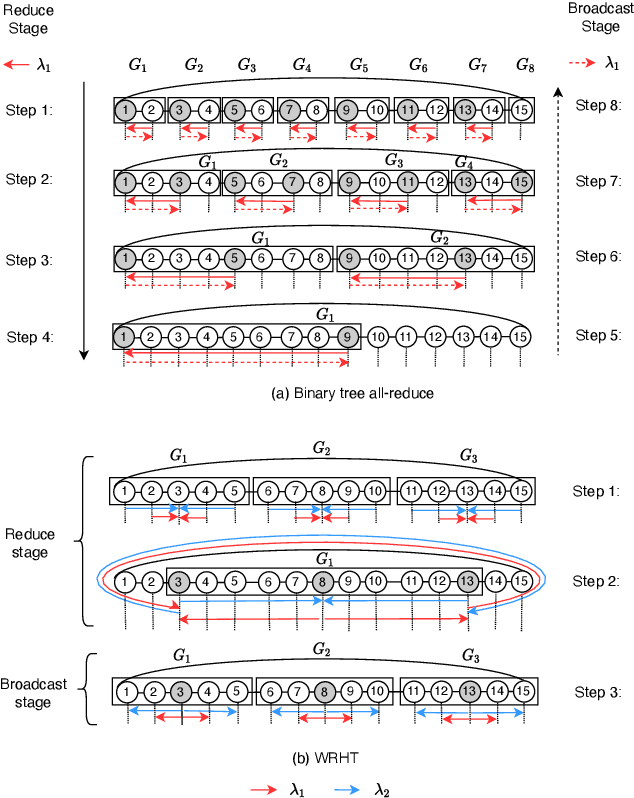
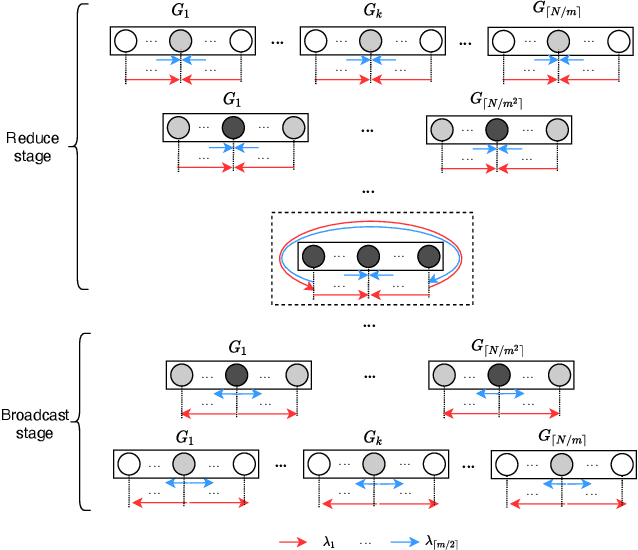
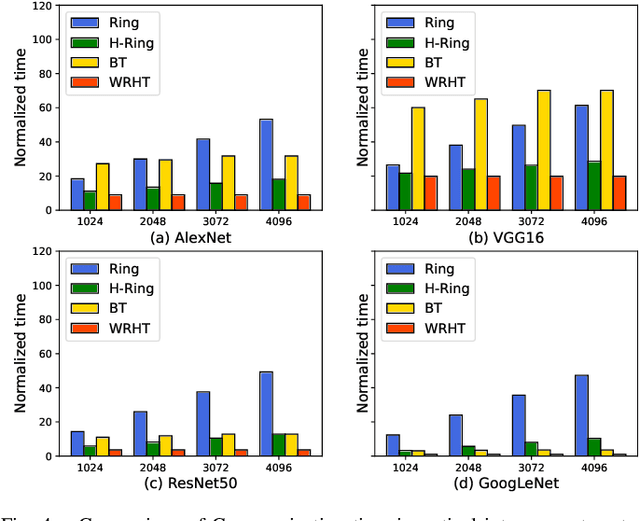
Abstract:Communication efficiency plays an important role in accelerating the distributed training of Deep Neural Networks (DNN). All-reduce is the key communication primitive to reduce model parameters in distributed DNN training. Most existing all-reduce algorithms are designed for traditional electrical interconnect systems, which cannot meet the communication requirements for distributed training of large DNNs. One of the promising alternatives for electrical interconnect is optical interconnect, which can provide high bandwidth, low transmission delay, and low power cost. We propose an efficient scheme called WRHT (Wavelength Reused Hierarchical Tree) for implementing all-reduce operation in optical interconnect system, which can take advantage of WDM (Wavelength Division Multiplexing) to reduce the communication time of distributed data-parallel DNN training. We further derive the minimum number of communication steps and communication time to realize the all-reduce using WRHT. Simulation results show that the communication time of WRHT is reduced by 75.59%, 49.25%, and 70.1% respectively compared with three traditional all-reduce algorithms simulated in optical interconnect system. Simulation results also show that WRHT can reduce the communication time for all-reduce operation by 86.69% and 84.71% in comparison with two existing all-reduce algorithms in electrical interconnect system.
Data Encryption based on 9D Complex Chaotic System with Quaternion for Smart Grid
Jun 03, 2022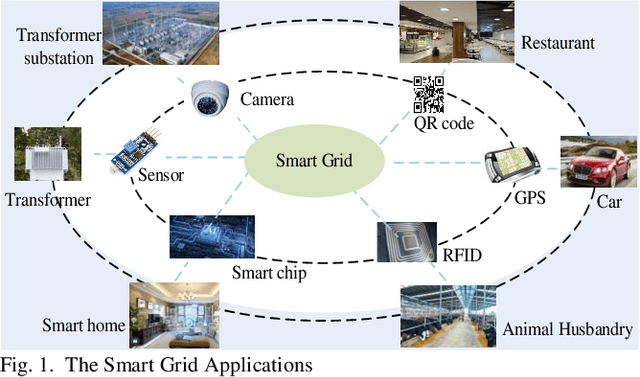
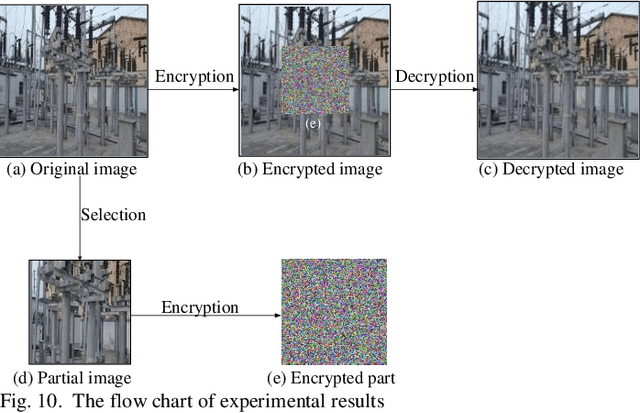
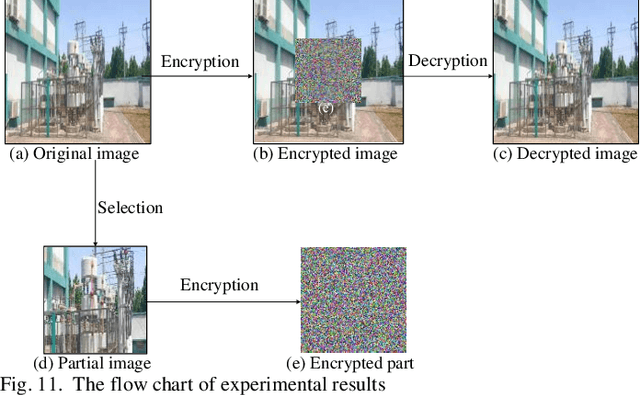
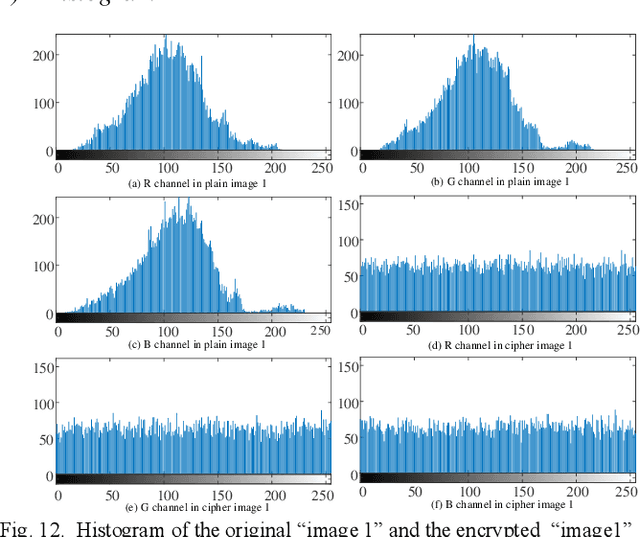
Abstract:With the development of smart grid, the operation and control of power system is realized through power communication network, especially the power production and enterprise management business involve a large amount of sensitive information, and the requirements for data security and real-time transmission are gradually improved. In this paper, a new 9D complex chaotic system with quaternion is proposed for the encryption of smart grid data. Firstly, a new 9D complex chaotic system with quaternion is proposed, and its attractors, bifurcation diagram, complexity, and 0-1 test are analyzed. Secondly, the pseudo-random sequences are generated by the new chaotic system to encrypt power data. Finally, the proposed encryption algorithm is verifed with power data and images in the smart grid, which can ensure the encryption security and real-time. The verifcation results show that the proposed encryption scheme is technically feasible and available for power data and image encryption in smart grid.
Multi-source data processing and fusion method for power distribution internet of things based on edge intelligence
Mar 30, 2022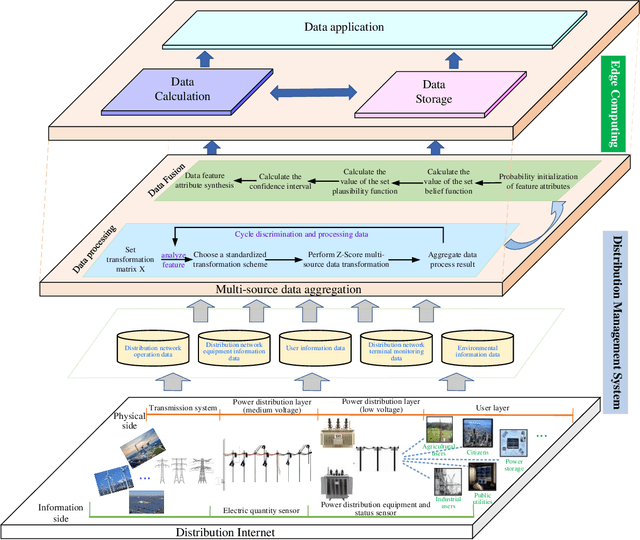



Abstract:With the rapid advancement of the Energy Internet strategy, the number of sensors within the Power Distribution Internet of Things (PD-IoT) has increased dramatically. In this paper, an edge intelligence-based PD-IoT multi-source data processing and fusion method is proposed to solve the problems of confusing storage and insufficient fusion computing performance of multi-source heterogeneous distribution data. First, a PD-IoT multi-source data processing and fusion architecture based on edge smart terminals is designed. Second, to realize the uniform conversion of various sensor data sources in the distribution network in terms of magnitude and order of magnitude. By introducing the Box-Cox transform to improve the data offset problem in the Zscore normalization process, a multi-source heterogeneous data processing method for distribution networks based on the Box-Cox transform Zscore is proposed. Then, the conflicting phenomena of DS inference methods in data source fusion are optimally handled based on the PCA algorithm. A multi-source data fusion model based on DS inference with conflict optimization is constructed to ensure the effective fusion of distribution data sources from different domains. Finally, the effectiveness of the proposed method is verified by an experimental analysis of an IEEE39 node system in a regional distribution network in China.
 Add to Chrome
Add to Chrome Add to Firefox
Add to Firefox Add to Edge
Add to Edge